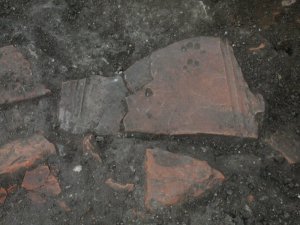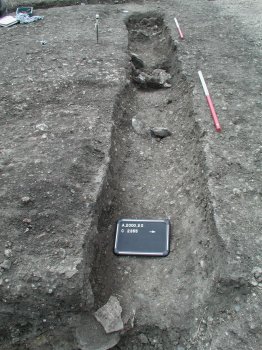| The 2000 Season:
Overview weeks 1 and 2
by Amanda Clarke |
| July 15th 2000:
The fourth season of excavation officially began on Monday July 3rd,
but the week before was spent clearing the site of last year's backfill
and preparing the area for the arrival of a team of over 80 people - both
students from the University of Reading and participants in the Field School.
We have now been on site for 2 weeks, and although the rainy weather has been physically uncomfortable at times, the damp conditions have been ideal for trowelling to reveal the colours and outlines of all the buildings and their surrounding areas. Work has gone extremely well in these first 2 weeks and the excavation of the late Roman streetfront is underway. |
We have lost half a day due to bad weather, but otherwise all aspects of excavation have gone according to plan. The environmental system is up and running with 20litre samples being collected from most features and contexts being excavated. These samples are run through a flotation tank on site, and the flots and residues collected and examined for charred plant remains, fish bone, charcoal and small artefacts. Alongside our paper record system we are operating an archaeological database on site, with all records being entered onto the computer daily. The excavation is, of course, open to the public, with students on hand to give guided tours. Our first Open Day is on Saturday July 22nd, with the site open to visitors from 10am. No advance booking is necessary - just turn up to hear about our latest discoveries and watch the archaeologists in action. |
| The Archaeology
Excavation so far has concentrated on revealing the late Roman buildings (post 250 AD) lining the sides of the main north-south street through the insula, as well as the late Roman occupation along the east-west street to the north of our excavation trench. Buildings 5, 7 and 8 have been trowelled clean and await excavation. Building 1 in the south-east corner of the trench has seen a concentration of effort, beginning with the excavation of all its foundation trenches. The construction levels for this building are now being recorded and removed, revealing evidence for earlier building phases. For example, a rough tiled surface is in the process of being uncovered in the southern area of this building. Several new flint-lined post-holes have also been excavated, cutting into the western edge of the main road. |
 |
 |
Elsewhere the expanses of late Roman dark soils have been cleaned and are revealing evidence for a large number of pits and post-holes, as well as robbed-out Roman wall trenches running parallel to the east-west street at the northern end of our excavation. As yet it is too early to say exactly what structures these wall trenches relate to, but they are certainly some of the latest on site. |
| We confidently predict the discovery of several large rubbish pits in the yards behind the late Roman buildings, and we will begin excavation of these during the coming week. Two possible wells have also been identified. At the moment we are concentrating on cleaning the sides of these wells, and drawing a half section through the deposits excavated. Already we are below the present day level of the water table, and so the water accumulating in the bottom of these features has to be removed by means of a mechanised pump. |
 |
|
Silchester
Home | Archaeology
Home | Reading
Home © 2002 Reading University Archaeology Department.
|